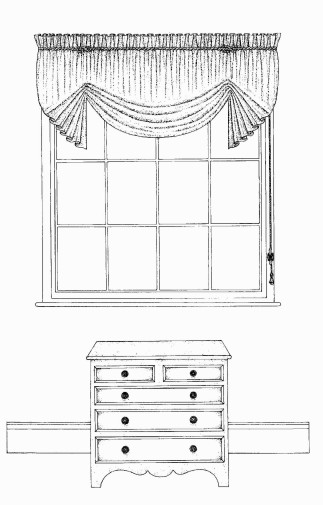
| Back to index Next Page Previous Page |
© Copyright Merrick & Day
• No space required at sides of window
• Can be used with curtains
• Ideal for small windows
• Economical on fabric
| Blinds can either be
used on their own as a simple treatment or in conjunction with curtains in a
multi-layered treatment. They are a useful treatment for small windows or for
windows where there is no space at the side for a curtain (for example, where a
cupboard butts up to the window). Blinds can be fitted either inside or outside
the window recess or architrave. The three main types of blinds are roller, Roman and Austrian. Roller and Roman blinds are simple flat blinds; Austrian blinds are gathered and more elaborate. A roller blind is pulled up and down by a spring mechanism, whereas Roman and Austrian blinds are pulled by cords. A blind can often solve the problem of which window treatment to use when there are dissimilar windows in the same room. It is possible to have an elaborate window treatment on a large window, and then use a roller or Roman blind, made up in the curtain fabric, on a small window in the same room. An Austrian blind would be an alternative option; continuity could be provided by using the same heading as the curtains or valance on the blind, as well as matching the fabric and other design details such as contrast binding, fringes or frills. ROLLER BLINDS These are simple functional blinds made out of a flat piece of stiffened fabric which is wound round a wooden or metal roller with a spring fixed onto the end. A wooden lath is inserted in the hem at the lower edge to keep the blind flat and straight. For added design detail the lower edge, below the lath, can be shaped and trimmed with braid or fringe. Where the top of the roller blind will be visible, it can be ‘reverse rolled’ so that the fabric falls in front of the roller. In this case the blind will stand 5cm (2in) proud of the window.  |
Roller blinds are a
practical solution for kitchen and bathroom windows and can be fitted neatly in
the recess of a window They can be bought ready-made in a standard range of
fabrics or instead can be custom-made in laminated fabrics. A useful device for
bedroom windows is to combine blackout roller blinds with curtains. Holland
blinds are roller blinds made out of plain woven cream cotton fabric. They
offer protection from harmful sunlight and are often used in conjunction with
curtains. ROMAN BLINDS These blinds provide a smart, tailored window dressing, suitable for modern as well as traditional rooms. They pleat up into even horizontal folds. To keep the folds straight and even, metal rods or wooden laths are inserted in pockets in the lining at regular intervals. The top of the blind is fixed onto a narrow wooden batten. The blind is drawn up by cords which are then wrapped around a hook. Roman blinds can look smart with inset borders or with a simple 2cm (3/4in) strip of contrast fabric along the lower edge. Alternatively, block fringe can be sewn along the lower edge for added texture and interest. Tournament blinds are Roman blinds with two or more vertical hands of braid or ribbon which are attached to each batten. The bands fall loosely when the blind is pulled up. Another stunning variation of a Roman blind is a fantail blind. The lower battens are split up the middle, so that when the blind is pulled up the broken battens form a fan shape. AUSTRIAN BLINDS These blinds are thought of as a feminine, frilly, window treatment, but they can take on a smart, formal look when made up in a damask and trimmed with fringe. They can have a gathered or a pleated heading and are corded to pleat up into soft scoops. The top of the blind is fixed onto a narrow wooden batten. It is drawn up by cords which are then wrapped in a figure of eight around a cleat hook. The wider the window, the more scoops in the Austrian blind. For a design variation the first scoop can be set in from the side edges so that the sides then drop down and form tails. However, the dropped-down sides will stop light coming into the room. London blinds are corded in the same manner as Austrian blinds. The fabric lies flat with an inverted pleat at each side of the blind. |
| Back to index Next Page Previous Page |